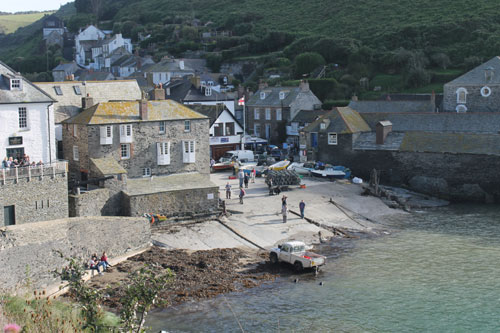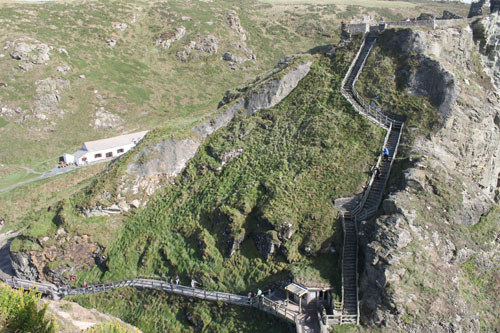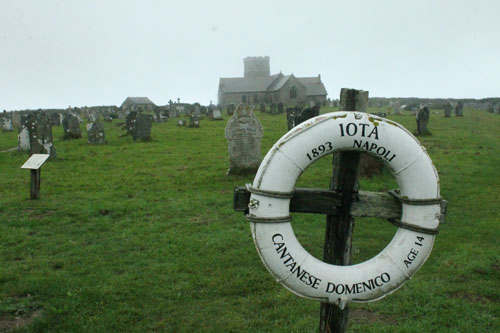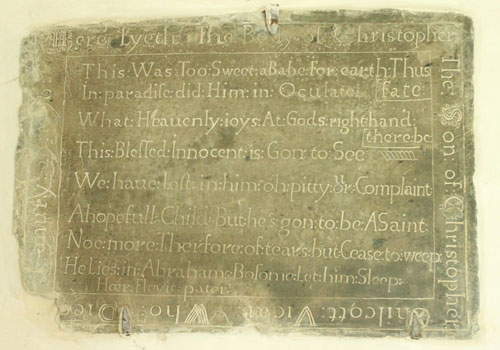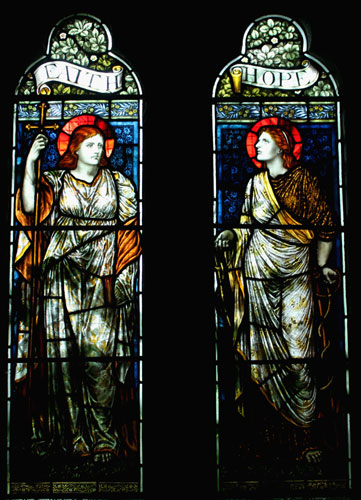Yesterday I was feeling quite sorry for Charles Rashleigh but I have to say, I’m feeling a lot sorrier for the people who live in the house used in Doc Martin for Doc Martin’s house. They have been forced to put up chains and Private Property signs across the front (ruining more than a few photographs, I’m certain).
The reason I know this is because today we found ourselves in the little fishing village of Port Isaac which becomes Port Wen on the TV. And there’s a lot of visitors that come, expecting everything to be exactly like it is on the TV. Well, almost all. We were talking to a couple in the Old School House while we were having a recuperative tea and coffee, and she has never seen it.
They were from Croydon and, upon hearing that Bob was from Sydney, her first question was “What channel is Doc Martin on in Melbourne?” A rather odd opening gambit. Particularly for someone who’s never watched it.
We needed to rest, having walked almost halfway up the ridiculously steep hill that takes you from the car park to the harbour. The streets aren’t just steep, they are also very narrow…pretty much like all the streets in Cornwell if I was being completely honest. Even so, cars still manage to get up and down without bumping into the houses either side.
While Port Isaac was undoubtedly very pretty, I thought it was ruined by the TV thing. There were a lot of people, wandering between the main buildings used for the series. There were gift shops selling Doc Martin themed ‘stuff’ rather than Port Isaac ‘stuff’. If anything, I didn’t think it felt quite real. Pretty but fake, I guess.
Mind you, we had just come from a pretty horrendous climb up to Tintagel Castle and could have been somewhat jaded. We had no idea it was so high up on the cliffs. You walk down, down, down almost to sea level and then you climb up, up, up till you touch the sky.
Why on earth anyone would build a castle in such an inaccessible spot is beyond me. And how he managed to convince a bunch of builders to actually do the work is even further away. He must have been blackmailing them.
Richard of Cornwall was the lunatic who decided it would be a great idea to build a castle on an island just off the mainland and connect it to a castle on the mainland via a drawbridge. And he had it built (I refuse to say he built it because he quite clearly did not) in around 1260. Then, less than 100 years later, a wall and half the great hall collapsed into the sea. Brilliant.
There was building there before Richard went mad but most of it was levelled to make way for the new castle. Clearly he didn’t get planning permission for it, otherwise the wall and great hall wouldn’t have fallen into the sea.
Obviously the castle was built to be easily defended and, according to Geoffrey of Monmouth, writing in the 12th century, you accessed the island by walking over a narrow isthmus which could be defended by three guards. I reckon a lot of people would have ended up going over the edge if they tried attacking.
Eventually there was no access to the island at all, what with erosion and bad planning, which prompted the vicar at the local parish church, Richard Byrn Kinsman to enlist the aid of a bunch of mad quarrymen, getting them to cut steps from the bottom to the top. As far as I can tell, Richard (yes, another Richard) did nothing but watch and offer prayers for the quarrymen’s safety.
Even these steps grew too dangerous, and, finally, in the 1970’s, the present bridge was built. Who knows how long it will last. And that was the bridge we walked across today. I have to say, the views and the “What the…?” effect were worth it but the steep, slippery steps are not something we’ll do twice.
There’s an awful lot of stuff I could write about Tintagel but, I’m not. Suffice to say, it’s an amazing place, particularly when the rain lets up and the sun appears just as you decide to go. We were very lucky!
Though, possibly one of my favourite things was the trip back up in the landrover. As Bob pointed out, poor Will, a rather big chap, was so squashed up in the back, he looked exactly like Alice when she grows inside the white rabbit’s house. While Will’s wife was highly amused by it all, Will was quite grim and didn’t really see the joke. Still, at least the sun was out.
It wasn’t quite so nice when we actually arrived in Tintagel in the first place. We parked and went into the pub as the rain drizzled down. After a sustaining pint, we wandered over to the Old Post Office which was built sometime between 1350 and 1400. As you can see, the roof is a bit wonky and it was raining.
While the building is called ‘The Old Post Office’ it only served in that capacity for about eight years. Before that it was a house that changed a lot over the years.
Then, during the Arthur-mania that swept the area in the late 19th century, caused by the damned romantic poets and their ideas of Arthurian legend and Tintagel being where he was supposedly born, lots of buildings in Tintagel were pulled down to make way for guest accommodation, pubs and gift shops.
The Old Post Office was auctioned (like so many others before) and would have been bulldozed as well if not for a group of local people led by the wonderful Miss Catherine Johns. They managed to buy the building with the proceeds of paintings and prints by local (and very famous) artists. Then, in 1895, they had it ‘done up’.
Eventually, in 1903, they sold it to the National Trust for £200. Bargain.
Having visited the Old Post Office, Mirinda and Bob went and experienced one of the most bizarre museums they’ve ever encountered (and I’m really hoping Mirinda makes an entry about it), while I walked the miles up to the parish church.
The parish church of St Materiana has been around since about 1100 and bits of the original church can still be seen inside. However, possibly the most poignant part of it is in the graveyard. A simple cross with a life buoy on it, sits just as you enter the church yard. It marks the grave of a 14 year old cabin boy (Domenico Cantanese) aboard the Iota which was wrecked on rocks nearby in 1893. The other eleven crew members were saved by local people during a horrendous storm. Poor Domenico drowned.
Somewhat odder is the brass for young Thomas Heming. He was struck by lightning in 1702 and his parents (or someone they knew) wrote a little poem about it. Essentially, the poem says that although struck by lightning and now dead, little Thomas is now in heaven.
Okay, that’s not odd. What is odd is that the second half of the poem goes on about God’s judgement and will, essentially saying that little Thomas had no choice but to die. The final few lines are:
O God the judgements of thy Seat
Are wonderous good and wonderous great
Thy ways in all thy works appear
As Thunder loud, as Lightning clear.
I find it very odd that parents could rejoice in the death of their child by, in their opinion, a god-created act of violence. I’d be asking why it had to happen; what poor Thomas had done to deserve it. The last thing I’d be doing was saying what a wonderful act of divine Providence it was. Mind you, the memorial brass is very pretty.
I mean, according to them, it was God’s fault. Still…there were also some lovely stained glass, including these pair who look pre-Raphaelite.
All up, we had a ridiculously full day. No wonder Bob doesn’t believe us when we say we generally take it very easy when on holidays.

